Related Research Articles
The following outline is provided as an overview of and topical guide to agriculture:

Agronomy is the science and technology of producing and using plants by agriculture for food, fuel, fiber, chemicals, recreation, or land conservation. Agronomy has come to include research of plant genetics, plant physiology, meteorology, and soil science. It is the application of a combination of sciences such as biology, chemistry, economics, ecology, earth science, and genetics. Professionals of agronomy are termed agronomists.
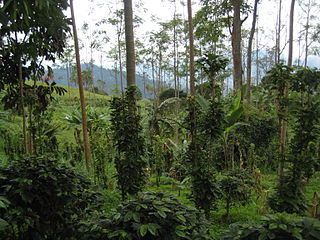
Sustainable agriculture is farming in sustainable ways meeting society's present food and textile needs, without compromising the ability for current or future generations to meet their needs. It can be based on an understanding of ecosystem services. There are many methods to increase the sustainability of agriculture. When developing agriculture within sustainable food systems, it is important to develop flexible business process and farming practices. Agriculture has an enormous environmental footprint, playing a significant role in causing climate change, water scarcity, water pollution, land degradation, deforestation and other processes; it is simultaneously causing environmental changes and being impacted by these changes. Sustainable agriculture consists of environment friendly methods of farming that allow the production of crops or livestock without damage to human or natural systems. It involves preventing adverse effects to soil, water, biodiversity, surrounding or downstream resources—as well as to those working or living on the farm or in neighboring areas. Elements of sustainable agriculture can include permaculture, agroforestry, mixed farming, multiple cropping, and crop rotation.
Agroecology is an academic discipline that studies ecological processes applied to agricultural production systems. Bringing ecological principles to bear can suggest new management approaches in agroecosystems. The term can refer to a science, a movement, or an agricultural practice. Agroecologists study a variety of agroecosystems. The field of agroecology is not associated with any one particular method of farming, whether it be organic, regenerative, integrated, or industrial, intensive or extensive, although some use the name specifically for alternative agriculture.
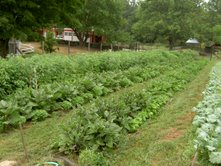
Agroecosystems are the ecosystems supporting the food production systems in farms and gardens. As the name implies, at the core of an agroecosystem lies the human activity of agriculture. As such they are the basic unit of study in Agroecology, and Regenerative Agriculture using ecological approaches.
A holon is something that is simultaneously a whole in and of itself, as well as a part of a larger whole. In other words, holons can be understood as the constituent part–wholes of a hierarchy. Holons are sometimes discussed in the context of self-organizing holarchic open (SOHO) systems.

Intercropping is a multiple cropping practice that involves the cultivation of two or more crops simultaneously on the same field. The most common goal of intercropping is to produce a greater yield on a given piece of land by making use of resources or ecological processes that would otherwise not be utilized by a single crop.
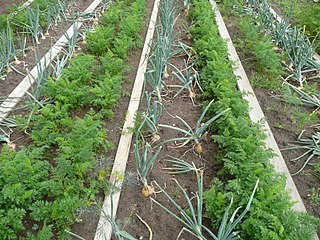
In agriculture, polyculture is the practice of growing more than one crop species in the same space, at the same time. In doing this, polyculture attempts to mimic the diversity of natural ecosystems. Polyculture is the opposite of monoculture, in which only one plant or animal species is cultivated together. Polyculture can improve control of some pests, weeds, and diseases while reducing the need for pesticides. Intercrops of legumes with non-legumes can increase yields on low-nitrogen soils due to biological nitrogen fixation. However, polyculture can reduce crop yields due to competition between the mixed species for light, water, or nutrients. It complicates management as species have different growth rates, days to maturity, and harvest requirements: monoculture is more amenable to mechanisation. For these reasons, many farmers in large-scale agriculture continue to rely on monoculture and use crop rotation to add diversity to the system.
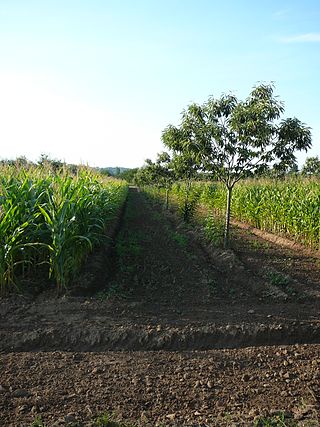
Agroforestry is a land use management system in which combinations of trees or shrubs are grown around or among crops or pastureland. Agroforestry combines agricultural and forestry technologies to create more diverse, productive, profitable, healthy, and sustainable land-use systems. There are many benefits to agroforestry such as increasing farm profitability. In addition, agroforestry helps to preserve and protect natural resources such as controlling soil erosions, creating habitat for the wildlife, and managing animal waste. Benefits also include increased biodiversity, improved soil structure and health, reduced erosion, and carbon sequestration.

Systems ecology is an interdisciplinary field of ecology, a subset of Earth system science, that takes a holistic approach to the study of ecological systems, especially ecosystems. Systems ecology can be seen as an application of general systems theory to ecology. Central to the systems ecology approach is the idea that an ecosystem is a complex system exhibiting emergent properties. Systems ecology focuses on interactions and transactions within and between biological and ecological systems, and is especially concerned with the way the functioning of ecosystems can be influenced by human interventions. It uses and extends concepts from thermodynamics and develops other macroscopic descriptions of complex systems.

Participatory technology development (PTD) is an approach to learning and innovation that is used in international development as part of projects and programmes relating to sustainable agriculture. The approach involves collaboration between researchers and farmers in the analysis of agricultural problems and testing of alternative farming practices.

Agroecology is an applied science that involves the adaptation of ecological concepts to the structure, performance, and management of sustainable agroecosystems. In Latin America, agroecological practices have a long history and vary between regions but share three main approaches or levels: plot scale, farm scale, and food system scale. Agroecology in Latin American countries can be used as a tool for providing both ecological, economic, and social benefits to the communities that practice it, as well as maintaining high biodiversity and providing refuges for flora and fauna in these countries. Due to its broad scope and versatility, it is often referred to as "a science, a movement, a practice."
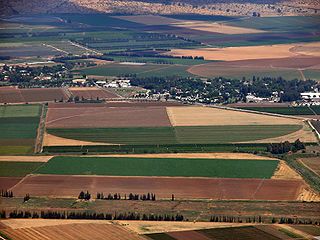
Biodiversity in agriculture is the measure of biodiversity found on agricultural land. Biodiversity is the total diversity of species present in an area at all levels of biological organization. It is characterized by heterogeneous habitats that support the diverse ecological structure. In agricultural areas, biodiversity decreases as varying landscapes are lost and native plants are replaced with cultivated crops. Increasing biodiversity in agriculture can increase the sustainability of farms through the restoration of ecosystem services that aid in regulating agricultural lands. Biodiversity in agriculture can be increased through the process of agroecological restoration, as farm biodiversity is an aspect of agroecology.
The ecology of contexts is a term used in many disciplines and refers to the dynamic interplay of contexts and demands that constrain and define an entity.
Miguel Altieri is a Chilean born agronomist and entomologist. He is a Professor of Agroecology at the University of California, Berkeley in the Department of Environmental Science, Policy and Management.

Michael Bell is an American sociologist, author, and musician. He is currently Vilas Distinguished Achievement Professor of Community and Environmental Sociology at the University of Wisconsin-Madison, where he is Chair of the Department of Community and Environmental Sociology. In addition, Bell served as Director of UW-Madison's Center for Integrated Agricultural Systems (CIAS) from 2011 to 2019. Created in 1989, CIAS is a research center for sustainable agriculture programs that respond to the needs of farmers and citizens.

Natural farming, also referred to as "the Fukuoka Method", "the natural way of farming", or "do-nothing farming", is an ecological farming approach established by Masanobu Fukuoka (1913–2008). Fukuoka, a Japanese farmer and philosopher, introduced the term in his 1975 book The One-Straw Revolution. The title refers not to lack of effort, but to the avoidance of manufactured inputs and equipment. Natural farming is related to fertility farming, organic farming, sustainable agriculture, agroecology, agroforestry, ecoagriculture and permaculture, but should be distinguished from biodynamic agriculture.

Regenerative agriculture is a conservation and rehabilitation approach to food and farming systems. It focuses on topsoil regeneration, increasing biodiversity, improving the water cycle, enhancing ecosystem services, supporting biosequestration, increasing resilience to climate change, and strengthening the health and vitality of farm soil.

Ivette Perfecto is an ecologist and professor at the University of Michigan. Her work focuses on complex ecosystem dynamics and the application of ecological theories to agricultural systems.
A number of movements seek to expand the practice of agroecology in West Africa. Agroecology is a scientific discipline, movement and practice that integrates ecology in agriculture with strong emphasis on diversification, food sovereignty, energy efficiency and sustainability. Agroecological practices apply the systems and knowledge that traditional farmers in the region have developed and inherited. The agroecological social movement empowers smallholder farmers that hold the knowledge of indigenous farming systems, however are recently engulfed by larger farms or are migrating to urban areas, looking for better paying jobs.
References
- ↑
- Koestler, Arthur, 1967. The Ghost in the Machine. London: Hutchinson. 1990 reprint edition, Penguin Group. ISBN 0-14-019192-5.
- ↑
- Bland, W.L. and Bell, M.M., (2007) A holon approach to agroecology International Journal of Agricultural Sustainability 5(4), 280-294. abstract available here Archived April 26, 2012, at the Wayback Machine
- ↑
- Wealth Creation Wheel Archived September 7, 2008, at the Wayback Machine